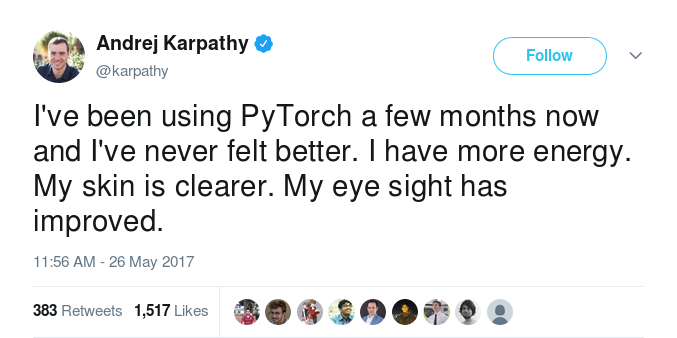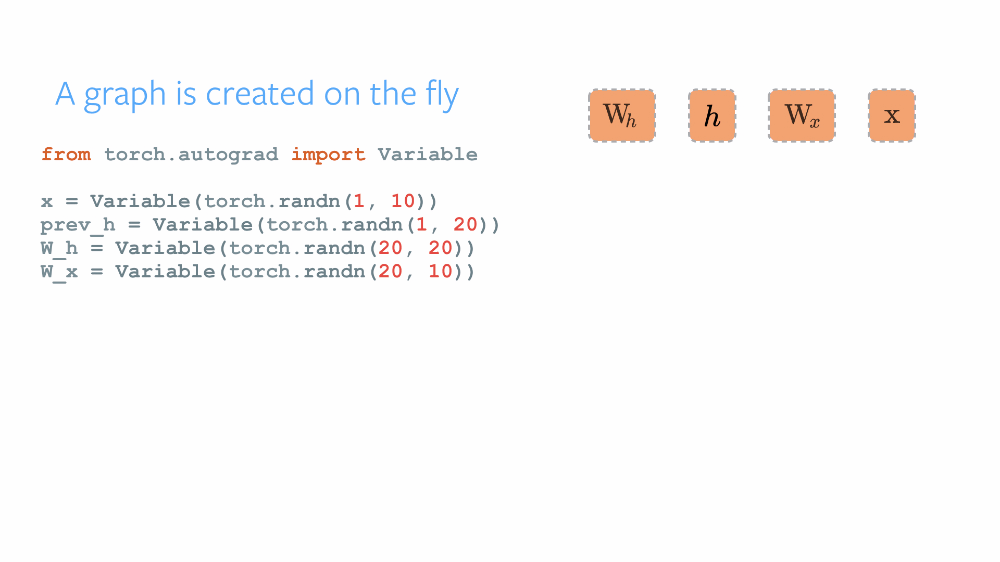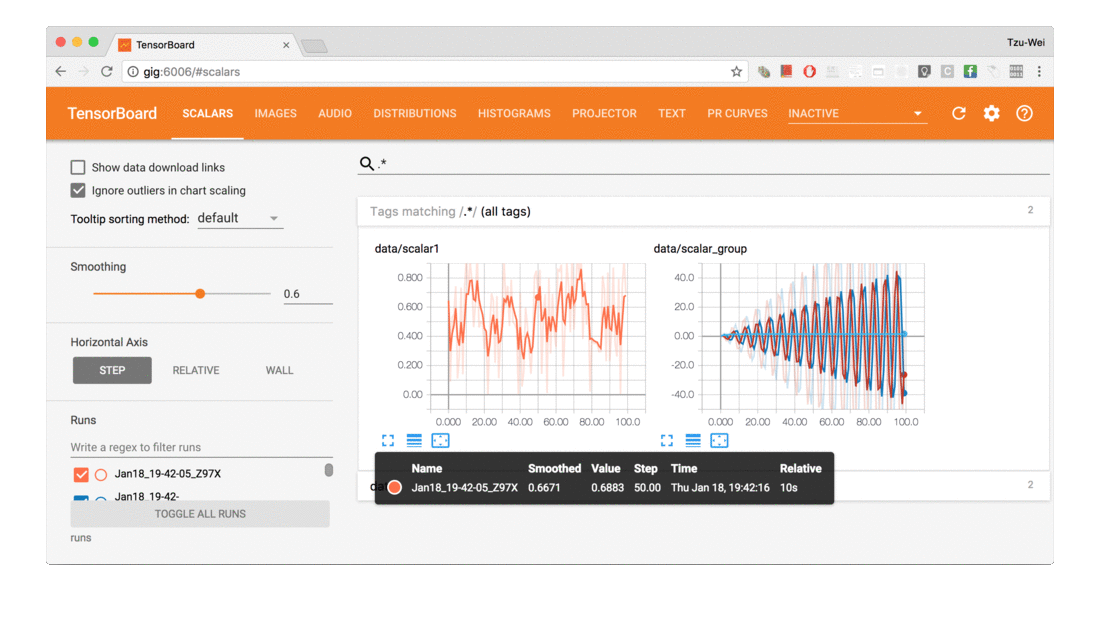
 Practical PyTorch 101
Practical PyTorch 101
Stefan Otte | stefan.otte@gmail.com | https://nodata.science
Thanks reinforce!
(Accompanying Workshop on the 22nd at 13:30)
(Material https://github.com/sotte/pytorch_tutorial WIP)
The Tyrrany of Choice & Why?¶
What is PyTorch?¶
"PyTorch - Tensors and Dynamic neural networks in Python with strong GPU acceleration. PyTorch is a deep learning framework for fast, flexible experimentation." -- pytorch.org
- eager execution or build-by-run (not build-then-run)
- PyTorch is like numpy (on the GPU and with autograd)
- concise API surface and good abstractions
- PyTorch is just stupid Python

import torch
from IPython.core.debugger import set_trace
def my_relu(x: torch.FloatTensor) -> torch.FloatTensor:
# set_trace() # <-- this!
if x < 0:
print("if branch. x:", x)
return x * 0
return x
x = torch.tensor(-2., requires_grad=True)
res = my_relu(x)
res.backward()
print("val: ", res.item())
print("grad:", x.grad.item())
if branch. x: tensor(-2., requires_grad=True) val: -0.0 grad: 0.0
"I don't get it" vs "WOOOW!"
What you don't see:
session.run(), tf.control_dependencies(), tf.while_loop(), tf.cond(), tf.global_variables_initializer()
TensorFlow 2¶
PyTorch Features¶
import torch
import torch.nn as nn
import torch.nn.functional as F
import torch.optim as optim
import torchvision.models
from ipdb import set_trace
DEVICE = torch.device(
"cuda:0" if torch.cuda.is_available()
else "cpu"
)
Tensors and GPU¶
a = torch.rand(3, 3)
a.shape
torch.Size([3, 3])
a + a @ a.t();
a = a.to(DEVICE)
a + a @ a.t();
a.cpu(); # a.cuda()
torch.nn¶
model = nn.Sequential(
nn.Conv2d(in_channels=1, out_channels=20, kernel_size=5),
nn.ReLU(),
nn.Conv2d(20, 64, 5),
nn.ReLU(),
nn.AdaptiveAvgPool2d(1),
)
batch = torch.rand(16, 1, 24, 24)
model(batch); # forward pass
class MyModel(nn.Module):
def __init__(self):
super().__init__()
self.conv1 = nn.Conv2d(in_channels=1, out_channels=20, kernel_size=5)
self.conv2 = nn.Conv2d(20, 64, 5)
def forward(self, x):
x = F.relu(self.self.conv1(x))
x = F.relu(self.conv2(x))
return F.adaptive_avg_pool2d(x, 1)
def bn_conv_relu(in_channels, out_channels, kernel_size=5):
return nn.Sequential(
nn.BatchNorm2d(in_channels),
nn.Conv2d(in_channels, out_channels, kernel_size),
nn.ReLU(),
)
model = nn.Sequential(
OrderedDict({
"conv1": bn_conv_relu(1, 20, 7),
"conv2": bn_conv_relu(20, 64),
"aap": nn.AdaptiveAvgPool2d(1),
})
)
model
Sequential(
(conv1): Sequential(
(0): BatchNorm2d(1, eps=1e-05, momentum=0.1, affine=True, track_running_stats=True)
(1): Conv2d(1, 20, kernel_size=(7, 7), stride=(1, 1))
(2): ReLU()
)
(conv2): Sequential(
(0): BatchNorm2d(20, eps=1e-05, momentum=0.1, affine=True, track_running_stats=True)
(1): Conv2d(20, 64, kernel_size=(5, 5), stride=(1, 1))
(2): ReLU()
)
(aap): AdaptiveAvgPool2d(output_size=1)
)
# move the model to the GPU
model = model.to(DEVICE);
# nn.Linear as example of nn.Module
lin = nn.Linear(1, 3, bias=True)
print(lin)
Linear(in_features=1, out_features=3, bias=True)
lin.state_dict()
OrderedDict([('weight', tensor([[0.5689],
[0.7325],
[0.9801]])),
('bias', tensor([ 0.1557, -0.9874, 0.5309]))])
for p in lin.parameters():
print(p)
print()
Parameter containing:
tensor([[0.5689],
[0.7325],
[0.9801]], requires_grad=True)
Parameter containing:
tensor([ 0.1557, -0.9874, 0.5309], requires_grad=True)
def init_weights(module):
if isinstance(module, nn.Linear):
print(f"Initializing {module} with uniform")
nn.init.uniform_(module.weight)
lin.apply(init_weights);
Initializing Linear(in_features=1, out_features=3, bias=True) with uniform
Dataset and DataLoader¶
from torch.utils.data import Dataset, DataLoader
dataset = torchvision.datasets.MNIST("data/raw/", download=True)
len(dataset)
60000
dataset[1]
(<PIL.Image.Image image mode=L size=28x28 at 0x7FF9B45EDF98>, 0)
print(f"Label: {dataset[1][1]}")
dataset[1][0]
Label: 0
dataloader = DataLoader(
dataset,
batch_size=64,
num_workers=4,
shuffle=True,
)
model + loss + optimizer¶
model # from above
loss_fn = nn.CrossEntropyLoss()
optimizer = optim.SGD(model.parameters(), lr=0.001)
optimizer = optim.SGD(
[
{"params": model.conv1.parameters(), "lr": 0.001},
{"params": model.conv2.parameters()}
],
lr=0.01,
)
Training Loop¶
def fit(model, loss_fn, optimizer, train_dl, valid_dl, n_epochs: int):
for epoch in range(n_epochs):
# TRAIN
model.train()
for x, y in train_dl:
x, y = x.to(DEVICE), y.to(DEVICE)
optimizer.zero_grad()
y_ = model(x)
loss = loss_fn(y, y_)
loss.backward()
optimizer.step()
# EVAL
model.eval()
with torch.no_grad():
for x, y in valid_dl:
x, y = x.to(DEVICE), y.to(DEVICE)
y_ = model(x)
loss = loss_fn(y, y_)
Multiple GPUs¶
model = nn.DataParallel(model)
Pre-Trained models¶
torchvision.models.resnet18(pretrained=True)
torchvision.models.densenet121(pretrained=True)
torchvision.models.inception_v3(pretrained=True)
torchvision.models.squeezenet1_1(pretrained=True);
import pretrainedmodels
pprint(sorted(pretrainedmodels.model_names))
['alexnet', 'bninception', 'cafferesnet101', 'densenet121', 'densenet161', 'densenet169', 'densenet201', 'dpn107', 'dpn131', 'dpn68', 'dpn68b', 'dpn92', 'dpn98', 'fbresnet152', 'inceptionresnetv2', 'inceptionv3', 'inceptionv4', 'nasnetalarge', 'nasnetamobile', 'pnasnet5large', 'polynet', 'resnet101', 'resnet152', 'resnet18', 'resnet34', 'resnet50', 'resnext101_32x4d', 'resnext101_64x4d', 'se_resnet101', 'se_resnet152', 'se_resnet50', 'se_resnext101_32x4d', 'se_resnext50_32x4d', 'senet154', 'squeezenet1_0', 'squeezenet1_1', 'vgg11', 'vgg11_bn', 'vgg13', 'vgg13_bn', 'vgg16', 'vgg16_bn', 'vgg19', 'vgg19_bn', 'xception']
PyTorch 1.0¶
- Focus: "from research to production"
- API mostly unchanged
- distributed backend redesigned
torch.jitto compile modelstorch.jit.tracetorch.jit.script
- LibTorch C++ frontend
- (ONNX - Open Neural Network eXchange format)
- (PyTorch -> ONNX -> whatever)
Ecosystem¶
- high-level training libs (ignite, TNT, skorch, fast.ai, PyToune, MagNet, etc.)
- AllenNLP, Flair, fairseq, Glow, Pyro, PySyft, GPyTorch
- https://colab.research.google.com/ supports PyTorch
- https://pytorch.org/ecosystem
Visdom¶

Recap¶
- PyTorch is just stupid Python
- PyTorch is like numpy (on the GPU and with autograd)
- small and concise API surface
DatasetandDataLoader
import torch.nn as nn
import torch.nn.functional as F
import torch.optim as optim
torch.jitand ONNX
- PyTorch and TensorFlow are converging
